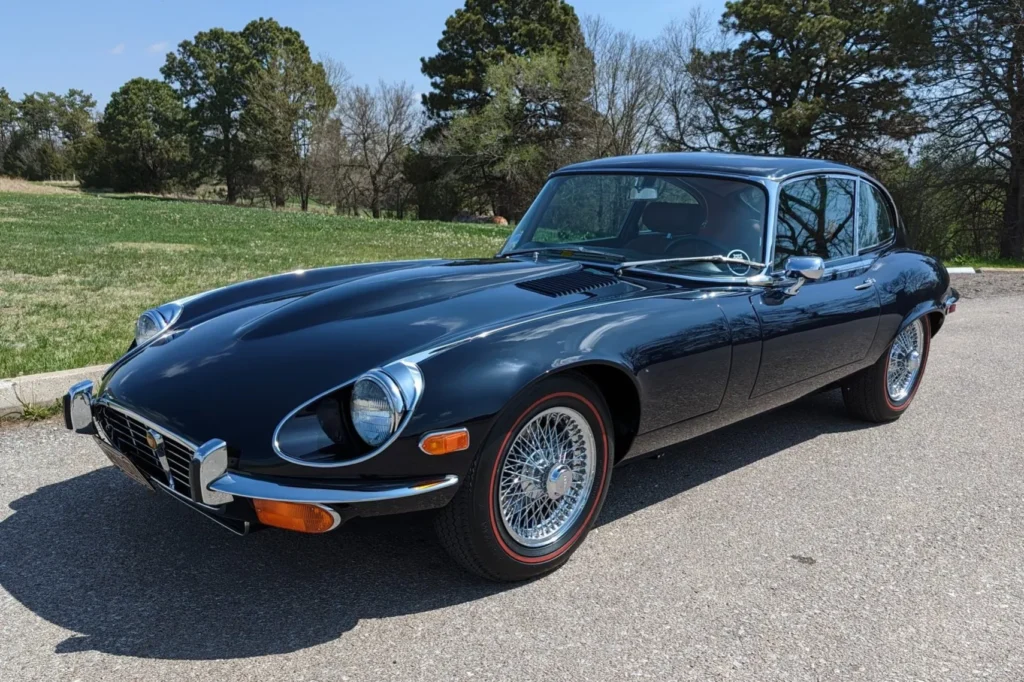1972 JAGUAR XKE SERIES III E-TYPE – FIRST YEAR OF THE THIRD GENERATION
Introduction:
The 1972 Jaguar E-Type Series III marks an essential year within the lineage of Jaguar’s prestigious sports cars. This detailed exploration provides an insight into various facets, including design, racing pedigree, innovative features, and its place within the larger context of the automotive industry.
Design: Continuity and Refinement
Exterior
The 1972 Series III continued the design features introduced with the Series III in 1971, including the large grille, flared wheel arches, and the quad exhaust pipes. Malcolm Sayer’s influence was still very much evident.
Interior
The interior continued to emphasize luxury and comfort. The 1972 model came with upgraded seats, finer trim materials, and optional extras like air conditioning.
Engine and Performance: The Mastery of the V12
The V12 Engine
Designed by Walter Hassan and Harry Mundy, the 5.3-liter V12 engine was the centerpiece of the Series III, and it continued to impress in the 1972 model. The engine’s 272 hp provided a top speed of over 140 mph.
Transmission
The 1972 Series III offered both 4-speed manual and 3-speed automatic transmission options. The manual was favored by driving enthusiasts, while the automatic offered a smooth, luxurious driving experience.
Racing History: The 1972 Impact
Private Teams
Private racing teams continued to field the E-Type in various competitions in 1972. The car’s performance and adaptability made it a favorite in various racing classes.
Successes and Challenges
In 1972, the Series III experienced mixed success on the racetrack. While it achieved wins and podium finishes in several competitions, it also faced challenges, especially against newer, more specialized racing machines.
Innovation and Technology: Setting Standards
Cooling System
The V12’s cooling system was further refined in 1972. It employed a larger radiator and twin cooling fans to manage the powerful engine’s temperature.
Suspension
The 1972 model continued to use the independent coil spring rear suspension and the anti-roll bars that made handling more precise and enjoyable.
Aerodynamics
The principles of aerodynamics played a vital role in shaping the 1972 E-Type. The design was carefully crafted to minimize drag, enhancing fuel efficiency and performance.
Variants and Special Models: A Tailored Experience
Roadster and 2+2 Coupe
The 1972 Series III was offered in two main variants: the Roadster and the 2+2 Coupe. This allowed Jaguar to cater to different segments of the market.
Global Impact: Success Across Borders
The American Market
The U.S. remained a crucial market for the 1972 Series III, and its design and features were partly tailored to meet American standards and tastes.
Export Success
In addition to the U.S., the 1972 Series III found success in various other markets, further solidifying the E-Type’s global appeal.
Cultural Impact: Continuing the Legacy
The 1972 Series III remained an icon, frequently appearing in media and popular culture. Its unique combination of performance and elegance kept it in the public eye.
Preservation and Collectibility: A Timeless Classic
Today, the 1972 Series III is a prized possession among collectors. Its unique blend of performance, style, and innovation has ensured its place as one of the most coveted classic cars.
Conclusion: The 1972 Series III – A Year of Distinction
The 1972 Jaguar E-Type Series III stands as a testament to a brand that has continuously striven for excellence in design, engineering, and performance. In a year of continuing evolution, the 1972 model carried forward the innovations introduced in the Series III while maintaining the E-Type’s essential character and appeal.
The design continued to reflect the brilliance of Malcolm Sayer, and the powerful V12 engine delivered performance that few could match at the time. On the track, the E-Type proved its mettle, showcasing adaptability and potential that would influence Jaguar’s racing endeavors in the years to come.
The innovative features, from the cooling system to the aerodynamics, reflected Jaguar’s commitment to being at the cutting edge of automotive technology. Meanwhile, the global reach of the 1972 Series III illustrated the brand’s ability to adapt and cater to diverse markets and regulatory environments.
At Sell A Classic Car, we are classic Jaguar buyers in California. If you’re planning to sell your classic Jaguar, call us at (310) 399-3990 or email us at info@westcoastclassics.com to get the best deal in cash!

